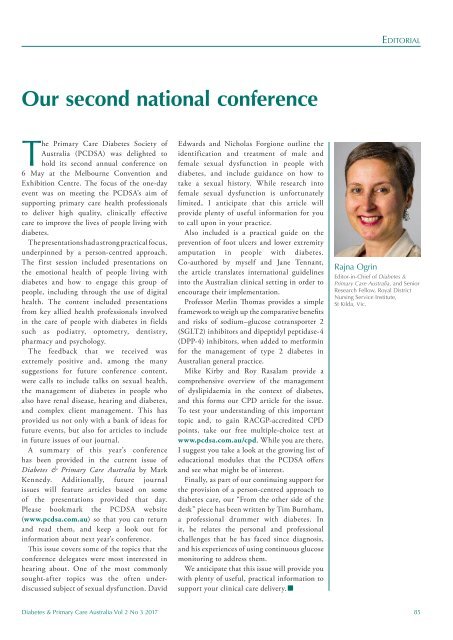DPCA 2-3_entire_v3
Create successful ePaper yourself
Turn your PDF publications into a flip-book with our unique Google optimized e-Paper software.
Editorial<br />
Our second national conference<br />
The Primary Care Diabetes Society of<br />
Australia (PCDSA) was delighted to<br />
hold its second annual conference on<br />
6 May at the Melbourne Convention and<br />
Exhibition Centre. The focus of the one-day<br />
event was on meeting the PCDSA’s aim of<br />
supporting primary care health professionals<br />
to deliver high quality, clinically effective<br />
care to improve the lives of people living with<br />
diabetes.<br />
The presentations had a strong practical focus,<br />
underpinned by a person-centred approach.<br />
The first session included presentations on<br />
the emotional health of people living with<br />
diabetes and how to engage this group of<br />
people, including through the use of digital<br />
health. The content included presentations<br />
from key allied health professionals involved<br />
in the care of people with diabetes in fields<br />
such as podiatry, optometry, dentistry,<br />
pharmacy and psychology.<br />
The feedback that we received was<br />
extremely positive and, among the many<br />
suggestions for future conference content,<br />
were calls to include talks on sexual health,<br />
the management of diabetes in people who<br />
also have renal disease, hearing and diabetes,<br />
and complex client management. This has<br />
provided us not only with a bank of ideas for<br />
future events, but also for articles to include<br />
in future issues of our journal.<br />
A summary of this year’s conference<br />
has been provided in the current issue of<br />
Diabetes & Primary Care Australia by Mark<br />
Kennedy. Additionally, future journal<br />
issues will feature articles based on some<br />
of the presentations provided that day.<br />
Please bookmark the PCDSA website<br />
(www.pcdsa.com.au) so that you can return<br />
and read them, and keep a look out for<br />
information about next year’s conference.<br />
This issue covers some of the topics that the<br />
conference delegates were most interested in<br />
hearing about. One of the most commonly<br />
sought-after topics was the often underdiscussed<br />
subject of sexual dysfunction. David<br />
Edwards and Nicholas Forgione outline the<br />
identification and treatment of male and<br />
female sexual dysfunction in people with<br />
diabetes, and include guidance on how to<br />
take a sexual history. While research into<br />
female sexual dysfunction is unfortunately<br />
limited, I anticipate that this article will<br />
provide plenty of useful information for you<br />
to call upon in your practice.<br />
Also included is a practical guide on the<br />
prevention of foot ulcers and lower extremity<br />
amputation in people with diabetes.<br />
Co-authored by myself and Jane Tennant,<br />
the article translates international guidelines<br />
into the Australian clinical setting in order to<br />
encourage their implementation.<br />
Professor Merlin Thomas provides a simple<br />
framework to weigh up the comparative benefits<br />
and risks of sodium–glucose cotransporter 2<br />
(SGLT2) inhibitors and dipeptidyl peptidase-4<br />
(DPP-4) inhibitors, when added to metformin<br />
for the management of type 2 diabetes in<br />
Australian general practice.<br />
Mike Kirby and Roy Rasalam provide a<br />
comprehensive overview of the management<br />
of dyslipidaemia in the context of diabetes,<br />
and this forms our CPD article for the issue.<br />
To test your understanding of this important<br />
topic and, to gain RACGP-accredited CPD<br />
points, take our free multiple-choice test at<br />
www.pcdsa.com.au/cpd. While you are there,<br />
I suggest you take a look at the growing list of<br />
educational modules that the PCDSA offers<br />
and see what might be of interest.<br />
Finally, as part of our continuing support for<br />
the provision of a person-centred approach to<br />
diabetes care, our “From the other side of the<br />
desk” piece has been written by Tim Burnham,<br />
a professional drummer with diabetes. In<br />
it, he relates the personal and professional<br />
challenges that he has faced since diagnosis,<br />
and his experiences of using continuous glucose<br />
monitoring to address them.<br />
We anticipate that this issue will provide you<br />
with plenty of useful, practical information to<br />
support your clinical care delivery. n<br />
Rajna Ogrin<br />
Editor-in-Chief of Diabetes &<br />
Primary Care Australia, and Senior<br />
Research Fellow, Royal District<br />
Nursing Service Institute,<br />
St Kilda, Vic.<br />
Diabetes & Primary Care Australia Vol 2 No 3 2017 85
















